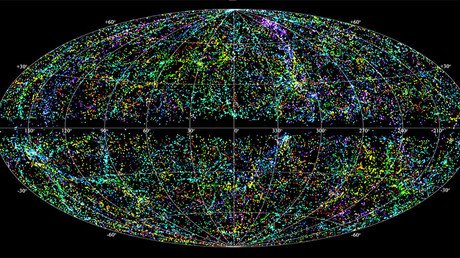Astounding double-ringed galaxy 'unlike any seen before'

A new double-ringed galaxy unlike “anything astronomers have observed before” has been spotted approximately 359 million light-years from Earth.
Named ‘PGC 1000714’ or ‘Burcin’s Galaxy’, the object has a “well-defined elliptical-like core surrounded by two circular rings,” according to astronomers.
It seems to belong to an extremely rare ‘hoag-type’ class of galaxy. Such galaxies are known for their round core surrounded by a ring, with nothing visibly connecting them. Much like galaxies in our own solar system, these are usually disc-shaped.
The exciting find was published in the ‘Monthly Notices of the Royal Astronomical Society’ by a team of researchers from the North Carolina Museum of Natural Sciences and the University of Minnesota Duluth.
“Less than 0.1 percent of all observed galaxies are Hoag-type galaxies,”says Burcin Mutlu-Pakdil, the paper’s lead author whom the galaxy was named after.
On Earth, Burcin’s Galaxy is only easily observed from the southern hemisphere. Working with a large diameter telescope in the Chilean mountains, the team captured multi-waved images to determine the ages of the galaxy’s two main features – the outer ring and the central body.
READ MORE: The 7 greatest scientific breakthroughs of 2016
The researchers found that the ‘young’ blue outer ring (0.13 billion years old) surrounds a red central core of about 5.5 billion years old. The biggest surprise, however, was the discovery of evidence of a second inner ring surrounding the core.
"We've observed galaxies with a blue ring around a central red body before, the most well-known of these is Hoag's object. However, the unique feature of this galaxy is what appears to be an older diffuse red inner ring,"says Patrick Treuthardt, co-author of the study.
The team believes the differing ring colors suggest two separate periods of the galaxy’s development. However, the theory needs further investigation, and the group plans to gather images of similar galaxies for comparison to build a better understanding of the rare galaxy’s evolution.
"Whenever we find a unique or strange object to study, it challenges our current theories and assumptions about how the Universe works. It usually tells us that we still have a lot to learn," says Treuthardt.













